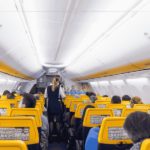The airline industry is contemplating a radical approach to ticket pricing that could fundamentally transform how passengers are charged for air travel. Weight-based ticket pricing, once dismissed as a radical concept, has emerged from the margins of transportation strategy to become a serious consideration for international carriers, igniting a complex debate that touches on environmental sustainability, economic efficiency, social justice, and human dignity.

Historical Context of Passenger Pricing
The notion of weight-influenced travel charges is not entirely unprecedented. Transportation systems have long grappled with weight as a fundamental factor in operational costs. Maritime shipping, freight transportation, and even public transit have historically incorporated weight considerations into their pricing models. Airlines, however, have traditionally maintained a more uniform approach to passenger pricing.
Samoa Air’s 2013 experimental ‘fat tax’ represented an early, controversial attempt to directly link passenger weight to ticket prices. The initiative was swiftly criticized and largely abandoned, seemingly confirming the industry’s reluctance to pursue such a sensitive pricing strategy. However, the recent resurgence of this concept suggests a more nuanced conversation is emerging.
The Finnair Data Collection Initiative
Finnair’s 2024 data collection project marked a significant moment in this evolving discussion. At Helsinki Airport, the airline implemented a voluntary weighing program where passengers could measure themselves alongside their carry-on luggage. This initiative was carefully framed not as a pricing mechanism, but as a method for improving aircraft balance and loading calculations.
The anonymized data collection—capturing only age, gender, and travel class—represented a methodical approach to understanding passenger weight distribution. By gathering information over a three-month period and applying it to both short and long-haul flights, Finnair positioned itself at the forefront of a potentially transformative research effort.
Environmental Calculations and Carbon Considerations
Climate researchers have introduced a compelling environmental perspective to the weight-based pricing debate. Precise scientific calculations demonstrate a direct correlation between aircraft weight and fuel consumption. Each additional pound on an aircraft incrementally increases fuel burn, with estimates suggesting that a 1% reduction in total aircraft weight could lead to approximately 0.75% fuel savings.
This environmental argument elevates the discussion beyond simple economic considerations. Weight-based pricing could potentially be framed as a climate action initiative, presenting airlines with a method to reduce carbon emissions while potentially optimizing operational costs.
However, emerging technologies offer alternative paths to reducing aviation’s environmental impact. Advanced lightweight materials, more fuel-efficient aircraft designs, and innovative engineering solutions provide potential alternatives to weight-based pricing strategies.
Public Sentiment and Social Dynamics
A comprehensive national survey revealed the nuanced public perception of potential weight-based pricing models. Researchers presented three distinct pricing scenarios to 1,012 U.S. adults: a standard fee with fixed luggage limits, a weight threshold charging extra for passengers over 160 pounds, and a fully weight-dependent ticket pricing system.
The results exposed intricate societal attitudes. Lighter passengers generally viewed weight-based pricing more favorably, while heavier passengers displayed a complex mix of skepticism and cautious openness. This data illuminates the deeply personal nature of pricing perceptions and the challenges of implementing such a strategy.
Technological and Design Innovations
The ongoing debate has inadvertently spotlighted potential innovations in aircraft design and passenger accommodation. Aerospace engineers and designers are increasingly exploring seat configurations that offer greater flexibility and comfort for passengers of diverse body types.
Ergonomic research and advanced materials science are providing new insights into aircraft interior design. Adaptive seating systems, adjustable space configurations, and more inclusive design principles are emerging as potential solutions to the challenges of passenger accommodation.
Global Regulatory Landscape
International aviation authorities are carefully monitoring these discussions, aware of the complex legal and ethical implications of weight-based pricing strategies. Different global regions are approaching the issue with varying levels of regulatory scrutiny and openness.
Some nations view potential weight-based models through the lens of anti-discrimination legislation, while others are more focused on operational efficiency and environmental considerations. The international aviation community remains fundamentally divided, with no clear consensus emerging.
Medical and Psychological Perspectives
Healthcare professionals have introduced critical nuance to the discussion, emphasizing the complex relationships between body weight, health, socioeconomic factors, and individual circumstances. They caution against oversimplified approaches that might stigmatize or marginalize individuals based on physical characteristics.
Psychologists highlight the potential emotional and mental health impacts of such pricing strategies, warning that they could exacerbate existing body image issues and contribute to broader societal stigmatization.
Economic Analysis
From an economic perspective, weight-based pricing presents a complex optimization challenge. Airlines must balance operational efficiency, fuel costs, passenger satisfaction, and potential legal challenges.
The potential financial model offers both opportunities and significant risks. Precise cost allocation could improve operational margins, but might simultaneously alienate a substantial portion of the traveling public and potentially trigger complex legal challenges related to discrimination.
Conclusion
The weight-based airline pricing discussion represents far more than a simple economic calculation. It embodies a sophisticated intersection of environmental concerns, technological innovation, social justice, and fundamental human dignity.
Airlines find themselves navigating an increasingly complex landscape, attempting to balance operational efficiency with passenger experience, environmental responsibility with economic sustainability. The ultimate solution will likely require unprecedented collaboration between technology developers, healthcare professionals, social advocates, and transportation experts.
As the aviation industry stands at this critical crossroads, the path forward remains uncertain. The weight-based pricing discussion serves as a powerful reminder of the intricate, interconnected nature of modern transportation challenges—where technological innovation, environmental sustainability, economic efficiency, and human dignity must be carefully balanced.
The conversation continues to evolve, reflecting broader societal discussions about inclusivity, personal responsibility, and the future of transportation. What remains certain is that any potential solution will require extraordinary levels of empathy, scientific rigor, and a profound commitment to understanding the diverse needs of travelers in an increasingly complex world.





What concerns me more is that aircraft evacuation safety testing is based on able-bodied people being able to evacuate an aircraft in 90 seconds or less. Maybe before we start looking at peoples weight and charging more, the airlines should start looking at the safety standards placed on them and whether in todays world they are realistic given the wide range of body sizes and the prevalence of emotional support animals on aircraft.
If the airline provided seats that remotely fit those of larger stature I could get behind this. But charging more for a 6’5” man weighing 250lbs and providing the same seat I am jammed into at 5’2” and 150lbs is unconscionable.